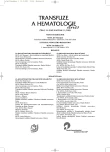Benefit of the different sensitivity of aPTT reagent for diagnosis of lupus anticoagulant inhibitor
Authors:
A. Buliková 1; J. Zavřelová 1; D. Néméthová 2; M. Penka 1; L. Dušek 2
Authors‘ workplace:
Oddělení klinické hematologie Fakultní nemocnice Brno
1; Centrum biostatistiky a analýz Masarykova Univerzita Brno
2
Published in:
Transfuze Hematol. dnes,11, 2005, No. 3, p. 98-103.
Category:
Comprehensive Reports, Original Papers, Case Reports
Overview
The authors summarise their own experience concerning to the application of the different sensitivity of aPTT reagents to lupus anticoagulant (LA) presence in the diagnostic process of the unspecific inhibitor of blood coagulation. By retrospective analysis of 100 LA positive and 100 LA negative samples we proved that value R (ratio of patient time/normal plasma time) is statistically different in LA positive and LA negative findings, in which lupus anticoagulant presence was determined by standard diagnostic procedures using criteria of the Standardisation Committee of International Society of Thrombosis and Haemostasis. These differences become more significant if use the index RLA. The application of logistic regression permits differentiation of LA positive and LA negative samples on the basis of only this one criterion. The specific adjustment allows application even in patients with anticoagulant therapy, in whom the diagnostic procedure is otherwise much more complicated.
Key words:
lupus anticoagulant, diagnostic procedure, aPTT reagent sensitivity
Labels
Haematology Internal medicine Clinical oncologyArticle was published in
Transfusion and Haematology Today

2005 Issue 3
Most read in this issue
- Hereditary hemochromatosis
- Benefit of the different sensitivity of aPTT reagent for diagnosis of lupus anticoagulant inhibitor
- LDL apheresis – evaluation of the results from 1000 performed procedures
- Detection of minimal residual disease in acute lymphoblastic leukemia using quantification of immunoglobulin and T-cell receptor genes rearrangements. How to avoid misinterpretation of the results
